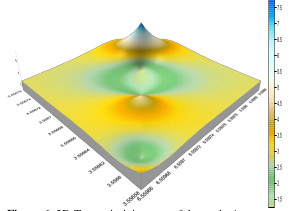AQUIFER CHARACTERIZATION ANALYSIS USING GEOELECTICAL PARAMETERS: A
Keywords:
Electrical resistivity, Geo-electrical parameters, Protective Capacity, AquiferAbstract
The groundwater potential and protective capacity of road 4 Olabisi Onabanjo University premises was investigated using Electrical resistivity method. The method was used to determine the depth to basement of locations in the study area to delineate possible groundwater potential and its protective capacity. Ten (10) VES were conducted using Schlumberger configuration for the data acquisition at 5 m interval from each station using SAS 1000 terrameter. The field data were analyzed using manual and computer iterations. The Geo-electrical parameters analyzed include resistivity and thickness of Topsoil, Weathered and Fractured/Fresh
basement resistivity and thickness and depth to basement. The interpretation delineates three layers overlying the fresh basement. These layers are topsoil, weathered layer and the fresh basement. The topsoil has resistivity values that range between 59.6-1013.5 Ωm with thickness range of 0.7-2.7 m, weathered layer has the resistivity value ranging from 53.4-266.2 Ωm with thickness ranging from 8.8-30.2 Ωm which is composed of medium sand with few clay. The curve types obtained were KH, HA and H with about 60% of KH curve. The last layer has the resistivity value of 307.8-2329.6 Ωm. The longitudinal conductance, hydraulic conductance, transmissivity and overburden thickness values and maps were also generated to characterize the aquifer of the study area. The protective capacity rating of the study area is rated poor, weak and moderate, but the moderate zones have the highest portion of the study area. VES 1, 2, 5 and 6 were grouped as moderate groundwater protective zones and it’s located at the northern part of the study area. The depth to
basement ranges between 12.5-36.1 m while the overburden thickness values ranges between 8.8 to 30.2 m. The study area is said to have good groundwater potential and protective capacity.
Downloads
References
Plummer, C. C., Mc Geory, D. and Carlson, D. H. (1999). Physical Geology. 8th Edition, McGraw Hill Co. Inc., New York, pp: 48-56.
Ariyo, S. O., Folorunso, A. F. and Ajibade, O. M., (2011). Geological and geophysical evaluation of the Ajana area’s groundwater potential, southwestern Nigeria. Earth Sci. Res. J., June 2011, vol. 15(1): 35-40.
Henriet, J. P. (1976). Direct applications of the Dar Zarrouk parameters in ground water surveys. Geophysical prospecting, 24:345-353.
Barker, R. D. (2001). Imaging fractures in hard rock terrain. Research Note 2, University of Birmingham, UK. 1–4.
Akana, T. S., George, G. C., Oki, O. A. (2016). Aquifer vulnerability assessment in some towns of Yenogoa, Southwestern Nigeria. Science and Technology 6(1): 15-23.
Olorunfemi, M. O, Ojo, J.S. and Oladapo. M.I. (1998). Geological hydrogeological and geophysical Investigation of exposed 20 Escravos Lagos Pipeline. Technical report.
Rahaman .M. A. (1972). Review of basement complex of South-western N Nigeria, Geology of Nigeria. 2nd Edition
Ajibade A. C. (1979). The Nigerian Precambrian and the Pan-African Orogeny. In: The Precambrian Geology of Nigeria (P.O. Oluyide et al, eds); Proceedings of the first symposium on the Precambrian Geology of Nigeria, Geological Survey of Nigeria, pp. 45-53.
Kehinde Philips O.O. (1992). Geology of Ogun State. In Onakomaya, S.O. Oyesiku, K.and Jegede, F. J. (eds.) Ogun State in Maps.Rex Charles Publications: Ibadan, Nigeria
Koefoed, O. (1977). Geosounding principles: Resistivity sounding measurements. Elsevier Scientific Publishing Company, 1979.
Oyedele K.F., Makinde V., and Coker J. O. (2009). Hydrogeophysical mapping of a basement aquifer by resistivity technique at akobo area, Ibadan, Southwestern Nigeria. Journal of Science Tech and Environment 9 (1&2), 22-28.
Coker J. O. (2012). Geostatistical analysis of the geoelectrical parameters of Oke-Badan estate, Akobo, South Western, Nigeria. International Archive of Applied Sciences and Technology; Vol. 3 (2) June 2012.
Makinde, V., Coker, J. O., and Oyedele, K. F. (2012). Hydrogeophysical mapping of Oke-Badan Estate Ibadan Southwestern Nigeria. International Journal of Basic and Applied sciences Vol. 11: 11-20
Okhue E.T., Olorunfemi, M.O. (1991). Electrical resistivity investigation of a typical basement complex area- the Obafemi Awolowo University Campus case study. J.Min. Geol. 27(2).66-70.
Oladimeji, L. A and Oluwaseun, S. O (2013). Evaluation of aquifer protective capacity of ground water resources within Afe- Babalola University, Ado-Ekiti, southwestern Nigeria: Transnational Journal of Science and Technology June edition Vol. 3(6)41-48.

Downloads
Published
Issue
Section
License
Copyright (c) 2023 The Journals of the Nigerian Association of Mathematical Physics

This work is licensed under a Creative Commons Attribution-NonCommercial-ShareAlike 4.0 International License.




